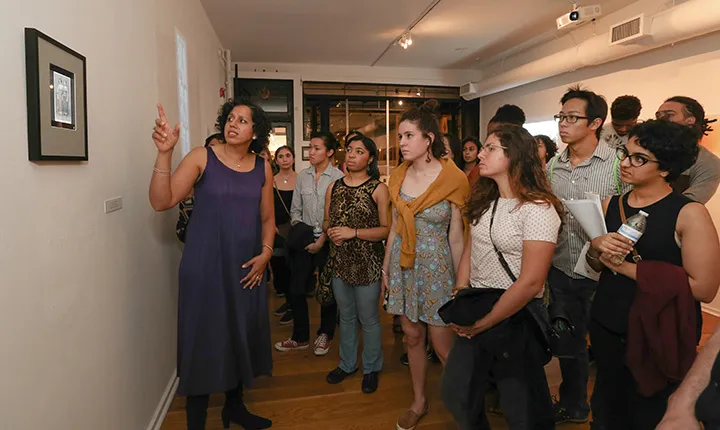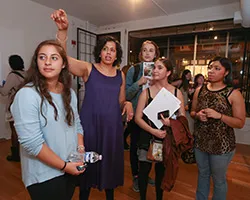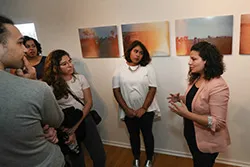Expanding the View

The gallery visit and private tour resulted from a partnership between Associate Professor of English Literature Bakirathi Mani (left) and the College's Lang Center for Civic & Social Responsibility aimed at expanding the worldview of students, collaboration with community partners, and experiential scholarship. Photos by Steven Falk.
It’s one thing to talk about art and culture in the classroom, says Jasmine Rashid ’18, quite another to encounter them.
“Culture and art are so human and essential that if you don’t experience them in the real world, it's just theory,” says the Massapequa, N.Y., native.
So when Rashid and her “What is Cultural Studies?” classmates were transported to a Center City Philadelphia art gallery last month, it imbued vitality and meaning to the lessons.
“We were no longer discussing abstract ideas,” says Nicole Banales ’18, of El Paso, Tex. “We were learning ideas right there in front of us that weren’t filtered through someone else’s words or experiences.”
The gallery visit resulted from a partnership between Associate Professor of English Literature Bakirathi Mani and the College's Lang Center for Civic & Social Responsibility aimed at expanding the worldview of students, collaboration with community partners, and experiential scholarship.
“It’s a model for my colleagues who are already doing great things with community partners,” says Mani. “These types of connections need to not only be enhanced, but made visible.”

Part of Mani's vision is to give students a glimpse of faculty research outside of the classroom.
Last year, the nonprofit arts organization Twelve Gates Arts approached Mani, whose research focuses on South Asian diasporic public cultures, to curate a South Asian arts exhibit. The opportunity dovetailed with her plans for a new course on cultural theory, as well as the Lang Center’s efforts to broaden its vision of global citizenship.
“That encompasses things like ethics, power, reciprocity, community, and identity,” says Ben Berger, interim executive director of the Lang Center, which sponsored the project. “Professor Mani’s idea hit on so many of them that it blew me away.”
The exhibit, Ruins and Fabrications, features works by Annu Palakunnathu Matthew and Gauri Gill. With photo paintings, digital animations, handmade accordion books, and rescued rolls of film, the artists “reframed the use of documentary and archival photography.”
The students studied visual and exhibition culture in Mani’s class this fall, as well as the artists’ statements and curatorial catalogs. Then they took a private tour of the exhibit hours before its early-November opening.
“[Gill] wrote a lovely note to me about how great it was to have the students kind of bless the space before it opened,” says Mani. “One of the best things about this group of students is that they’re so open to learning and take it seriously.”
The students applied their own critical perspectives. Particularly resonant for James Chen ’17 were photos rural Indian children took to document their lives but trashed because they were overexposed.
“These captured personal stories that you wouldn’t ordinarily learn about,” says the psychology major from Fremont, Calif. “It gave us a different perspective on looking at art and of experiencing a gallery.”

Students studied visual and exhibition culture in Mani’s class this fall before taking a private tour of the exhibit.
“I had an awesome appreciation of [Matthew’s] works from class,” adds Rashid, “but to see them actually displayed, using projection and the speed at which the images changed, added a new dimension.”
The students are drawing inspiration from the exhibit for their final projects, which range from music videos as a visual text to the ways different media portray images from news events such as the Ferguson shooting and protests.
“The exhibit showed us a lot about how different photos express different events in different ways,” says Chen.
Part of Mani’s vision was giving the students a glimpse of faculty research outside of the classroom, since, as she notes, “we don’t actually have labs in the humanities.”
Another draw was the opportunity to pierce the so-called Swarthmore “bubble” and immerse students in Center City. Whether they lack money, a clear plan, or the comfort level to put the books down for a night, the city remains an under-tapped resource for many students.
On this night, though — an unseasonably warm First Friday, with a brass band playing outside the gallery — its splendor was on full display. The students mingled with gallery owners and artists throughout Old City, and one even lined up an internship with a community partner.
“The College lights up when we hear that type of serendipity,” says Berger.
“We’re lucky to be positioned so closely to such an amazing resource, such a racially and economically diverse city,” says Mani. “And this was an opportunity to showcase the engagement that we as a college can have with Philadelphia.”
Annu Palakunnathu Matthew will discuss her work on campus Thurs., Dec. 3, at 4:30 p.m. in Science Center 101 at a public event presented by the Genevieve Ching-wen Lee '96 Memorial Fund. The Ruins and Fabrications exhibit runs in Philadelphia through December 15.



